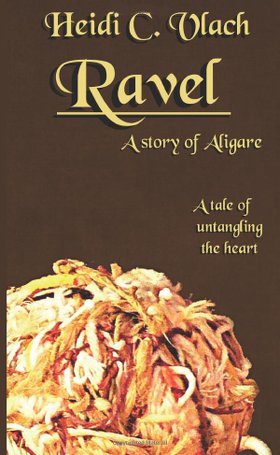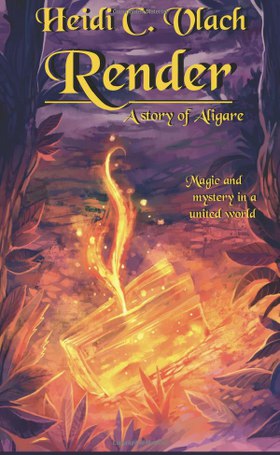Review: 'Remedy', 'Ravel', and 'Render', by Heidi C. Vlach
This story takes place on another world, among people who are not humans. The three peoplekinds live together in varied mixtures, with no history of war or racial strife. They work together and still have troubles to face.
All three books have this preface. The three peoplekinds are the tall dragonlike korvi (they are called dragons because of the similarity, though they have feathers instead of scales), the small weasel-like ferrin (they can ride on their korvi friends’ shoulders), and the green-skinned insect/humanlike aemet (with prominent antennae) who have the talent of making plants grow.
“Remedy: A Story of Aligare”. North Charleston, SC, CreateSpace, February 2011
Trade paperback $13.00 (5 + 439 pages), Kindle $2.99.
“Ravel: A Story of Aligare”. North Charleston, SC, CreateSpace, December 2011
Trade paperback $4.00 (91 pages), Kindle 99¢.
“Render: A Story of Aligare”. North Charleston, SC, CreateSpace, May 2013
Trade paperback $13.00 (703 pages), Kindle $2.99.
 Remedy opens with the korvi Peregrine of Ruelle at his ferrin friend Kelria’s funeral. Other mourners are Kelria’s daughter Tillian, who has taken her mother’s earferrin place on Peregrine’s shoulder; Peregrine’s korvi mate Giala; and “The rest of Redessence Clan, all of Peregrine’s and Giala’s adopted children” (p. 3).
Remedy opens with the korvi Peregrine of Ruelle at his ferrin friend Kelria’s funeral. Other mourners are Kelria’s daughter Tillian, who has taken her mother’s earferrin place on Peregrine’s shoulder; Peregrine’s korvi mate Giala; and “The rest of Redessence Clan, all of Peregrine’s and Giala’s adopted children” (p. 3).
‘I’ll be here a while,’ Peregrine said, hardly more than a breath. ‘Stay or go, however you need.’
Tillian slid closer to his neck – whiskers vibrated against his skin. ‘I’ll stay with you. We talked last night, just before she died, so … I don’t have anything to say to her remains.’
Already tethered to Peregrine. Already sitting with her long ears raised, ready to do earferrin duty. (p. 4)
Whatever Peregrine had done with himself thus far, however much more his arms successfully hauled, he was still a korvi. Still feathered sleek, still bearing feathered wings even if they lay on his back ignored more often than not. Air and wind and freedom might do him some good, vital as those things tended to be. He would have a needle-bright voice in his ear to encourage him, too. As he thought of Tillian, his pace quickened. (pgs. 8-9)
Tillian stretched to full attention, her head reaching the height of Peregrine’s knees. Her dove-grey fur was sleek, groomed with a meticulousness born of having nothing else to do. (p. 9)
I got the markers. Tillian opened her hands, letting the row of copper pegs flash.
Peregrine knelt, mantling his wings around his shoulders for balance, holding the feathered length of his tail level to the ground. ‘And you’ve got the stone with Fyrian’s snake on it?’
The … Oh, yes! Tillian’s ears twitched higher as she realized; she looked at the ties lining her sarong, and back up at Peregrine. I won’t untie it, I’ve got it in here. (p. 10)
With each new earferrin Peregrine taught, his memories bled together. Tillian would be the last. He had told himself that until his mind wore threadbare in the spot, and he told himself again now: he would oblige no more ferrin to spend their twenty-year lives on his shoulder. (p. 11)
‘I grew up with Peregrine,’ Tillian decided. ‘He’s been the way he is for a lot longer than I’ve been around, and he doesn’t try to hide it. So it’s easy to tell what he’s hearing and what he’s not hearing. I’m just paying attention for the sounds I know he can’t hear, and I tell him if any of them matter. Does that make sense?’ (p. 156)
Peregrine has spent his entire long adult life in the mines, chiseling out precious and semiprecious stones and carving them into decorative charms and trinkets for other korvi. With his two-hundred-year lifespan, he has grown despondent burying the generations of his shorter-lived ferrin friends. Now he has given that up, abandoning the mines to reaccustom himself to flight with his new friend Tillian on his shoulder. Their village, Skyfield, is mostly aemet-inhabited, with lots of large korvi and small ferrin lumbering and lolloping about.
Skyfield’s aemet mage Maythwind is always sending messengers on errands to neighboring villages, and Peregrine assumes that this will be a good way to start seeing the land. But Peregrine’s first errand takes him and Tillian to Valeover, just as that town is being overrun by refugees from Fenwater who are fleeing a deadly gripthia plague there. Rose, Fenwater’s young aemet mage, has ordered the evacuation of all healthy people in the whole town. Unfortunately, as all Aligare knows, evacuation of a town to stop a plague may do that, but it is just as likely to spread the plague by sending already-infected individuals into healthy villages.
Remedy splits into separate stories: that of Rose trying to succor the sick, and at the same time develop the science of medicine to replace superstitious prayers and magic spells; and that of Peregrine and Tillian, flying from village to village and hoping that they are not bringing the plague home to Skyfield. But weight counts, so Tillian stays behind at Fenwater after Peregrine goes there to see how bad things are, and Rose and Tillian have one adventure. A korvi newsspreader brings the news to Skyfield, and Giala flies to Fenwater to be with Peregrine, except that he’s not there and Giala is exposed to the plague needlessly …
The plague causes all four, the two korvis, a ferrin, and an aemet, to grow in unexpected ways.
 Ravel, a novelette that looks very thin next to the two novels, presents Aster Hane, a typical aemet housewife in Twillhome town. She has a beloved husband, Orman, a brother, Rowstley, a young daughter, Briar, and she is a skilled weaver. She has nothing to want, until the day she goes shopping –
Ravel, a novelette that looks very thin next to the two novels, presents Aster Hane, a typical aemet housewife in Twillhome town. She has a beloved husband, Orman, a brother, Rowstley, a young daughter, Briar, and she is a skilled weaver. She has nothing to want, until the day she goes shopping –
Fellow aemets shifted aside by polite fractions as Aster approached. Three dozen of their kind gathered about the dragon fellow; they looked like close-gathered oak saplings, slender and green. Antennae cut the air as folk turned to one another, murmuring. Words flowed on mouth-moist air.
The korvi stood before them. He looked relaxed there, smiling, his tail and two legs forming a rakish tripod on his red-patterned barding blanket. His build was wiry, all joints. His horns had grown barely long enough for a second bend. This, plainly, was a young wanderer. He unhooked a tonebox from his pants waistband, its dented metal scooping the light. Unhurried, the korvi rubbed an apparent smudge from the tonebox’s surface. Some measure of time passed behind his eyes; anticipation needled the air. And then the korvi bowed grand, spreading his wings wide as generosity. He met his audience’s eyes – Aster’s eyes, too, and for one heartbeat she knew him.
‘Good day, friends.’ He smiled, showing every tooth in his long mouth. ‘My name is Llarez of Arkiere.’ (pgs. 9-10)
As Llarez tells his bard’s tales, Aster suddenly realizes that she is bored with her humdrum life in Twillhome. After Llarez finishes his performance and is packing to leave, Aster invites him to her home, to help oil her loom.
Then it is only polite to ask him to stay for dinner, where he fascinates young Briar:
The dear child shrank against Rowstley’s leg, wide-eyed.
Ten months of life hadn’t shown Briar many dragon folk. She was still speckled with moss-coloured birth spots – still young enough to be prudently shy – and she was unaccustomed to the air movements of a korvi, the deluge of air currents funneled through their feathers. It wasn’t a feeling much different from a field of grass. Aster could introduce that much to her daughter, in the lifetime to come. (pgs. 24-25)
Llarez stays a few days as the Hane’s house guest – which stretch on. He eventually moves on, but he leaves his influence behind him. Briar has become a glutton for fanciful tales, and after Aster has repeated all that she remembers of Llarez’s tales, she begins to make up her own. Two years later, Aster’s second child is born, Gareth, a son. The children spend most of the day in Twillhome’s town broodery:
Voices rose in greeting as Aster approached, as aemet children sensed her samekind shape parting the still air. The brooder ferrin – bright-eyed weasel folk, smaller than the aemet children they guarded – hopped to Aster’s feet and reported on the day’s activities. (p. 52)
But Aster never stops thinking about Llarez’s tales. When Llarez returns to Twillhome, Aster must decide whether to continue her life in the town, or to accompany Llarez when he leaves to see the world.
 Render could be called a leisurely suspense novel. It begins:
Render could be called a leisurely suspense novel. It begins:
She had only lived six years out of the brooder, but Rue could still see how odd this was. Aemetkind didn’t leave their homes behind without a hard-driving reason. And this day, they had no danger to run from, only uncertainty they were walking straight toward. It didn’t make any great weight of sense. (p. 7)
Moving day arrived. Rue held her bitter worries and watched the caravan shuddering ahead. […] Rue could airsense the wind’s shapes, parting around the horses, split further by ears and legs and mane hair – then smashed back into large draughts against square cart surfaces. (p. 8)
So the world of Aligare has horses – also rabbits, squirrels, and, as soon becomes relevant, wolves.
Rue Tennel, her mother, and some neighbors in the village of Ordiny set out to establish a new mountain village, Aloftway. As the weeks and months pass, Rue turns out to have a talent for finding mushrooms and other edible plants while the new villagers clear land and wait for the first crops to come in.
And then neighbors began asking for her. Other aemets foraged, with their whole days or simply with their free moments – but when a particular food was craved, or when Amarantha wanted valerian stems for her nerves, Rue’s name sprang from people’s mouths. Due to her luck. Always her luck. Never the careful moments she spent walking and searching, mixing soil and water and dye, carefully remembering the resulting colours. Folk didn’t even think to credit the simple act of leaving the house and searching for things. But in this small village perched on a mountainside, it didn’t matter why Rue succeeded in finding food: it only mattered that she did. Not one traveller had arrived in these first months, not one korvi drifting in the mountain wind. (p. 55)
Years pass. Aloftway grows, but not by much. Rue senses that the location for the village had been chosen badly; crops are tended carefully, but they do not do well in the local soil. Aloftway gains a few ferrin and korvi as inhabitants, but not as many as a village should have.
In the cool of sowing season, in Rue’s fourteenth year of life, she found a sturdy stick in a cluster of fallen branches. Sturdy enough to be a walking stick. Rue eyed the length of the maple wood. It could help her leap-skip across rocky patches – and, she supposed in an afterthought, she could throw it as a distraction if a hunting beast attacked her. She had sensed forest wolves through the leaves more than once. Creatures like thick-built dogs, their gaze a weight Rue could feel. Because of shapes like that lurking among Verdana’s green, Aloftway’s aemet folk had been speaking more quiet worries in their gossip. The ferrin listened with fret-lowered ears, and brought nuts down whenever they climbed trees. (pgs. 63-64)
When the first badly savaged bodies of lone wanderers are found in the woods, wolves are blamed. The wolves haven’t bothered people before, but what else could it be? Aloftway will get guardian dogs. Rue is asked to find what might be called an old, surly korvi hermit, Felixi of Velgarro, a lone hunter who flies around that area and ask him to catch them some meat animals, partly to supplement the village’s diet but mostly to feed the dogs. The dogs, puppies, are brought by their aemet breeder to the village, and Rue is assigned one of them, Feor, since she forages in the forest so much. But time goes on; the dogs may be good protectors but they eat a lot of meat, and Aloftway goes on not growing. Felixi recommends hunting the wolves:
‘That’s not a choice when we’re a village mostly aemet.’
‘How many?’
‘One hundred – I don’t recall the exact number, it’s nearly one hundred and ten aemets now. Twenty-eight ferrin. And two korvi.’ (pgs. 348-349)
The plain fact is that as long as Aloftway has a reputation of its people being killed by wolves, nobody is going to move there. And unless Aloftway grows soon, it will become a failed village. The aemet do not hunt thinking beings – that’s why they need korvi like Felixi to hunt meat animals for their dogs – but unless they do something about the wolves, Aloftway is doomed. In fact, the village may not have that long to worry about it. As the wolves become bolder, Aloftway becomes a village under siege.
Vlach’s three (“so far”) stories of Aligare, with covers by Melanie Herring, are imaginative, well-written, and quite different from each other. Each is a stand-alone tale; the three can be read in any order. The trade paperbacks are very small books – 6.8” X 4.2”, with large type – so the three have really been designed for Kindle sales, to be read quickly.
One of the advantages of print-on-demand and e-books is that the author can change the text at any time. Vlach says that Remedy is a revised edition, made on May 4, 2011, with minor corrections and the diagram of the three species’ appearances that is now in all three stories. These three are definitely recommended, and leave the reader waiting for the next book.
About the author
Fred Patten — read stories — contact (login required)a retired former librarian from North Hollywood, California, interested in general anthropomorphics
Comments
Flayrah's on a "three alliterative titles" kick, apparently.
Edit: I said "Fred" originally, because alliteration, I guess. Whoops.
We have a review with four titles in the backlog, if it makes you feel any better. One of them doesn't even start with the same letter as the others! :-)
Post new comment